Trace Elements in Pernik Sub-Bituminous Coals and Their Combustion Products Derived from the Republika Thermal Power Station, Bulgaria
Abstract
1. Introduction
2. Coal Treatment and Burning
3. Sampling and Methods
4. Results
4.1. Mineralogy of the Coals and Combustion Products
4.2. Trace Elements
5. Discussion
5.1. Mineralogy of Combustion Products
5.2. Trace Elements
5.2.1. Trace Elements in Coals and Wastes from Preparation and Disposal Pond
5.2.2. Trace Elements in Bottom Ash and Bottom Ash Size Fractions
5.2.3. Contents and Distribution of Trace Elements in Fly Ashes
5.2.4. Behavior of REE
5.2.5. Correlations
6. Environmental Aspects
7. Conclusions
Author Contributions
Funding
Data Availability Statement
Acknowledgments
Conflicts of Interest
References
- Ketris, M.P.; Yudovich, Y.E. Estimation of Clarkes for Carbonaceous biolithes: World averages for trace element contents in black shales and coals. Int. J. Coal Geol. 2009, 78, 135–148. [Google Scholar] [CrossRef]
- Seredin, V.V.; Dai, S. Coal deposits as potential alternative sources for lanthanides and yttrium. Int. J. Coal Geol. 2012, 94, 67–93. [Google Scholar] [CrossRef]
- Dai, S.; Liu, J.; Ward, C.R.; Hower, J.C.; French, D.; Jia, S.; Hood, M.M.; Garrison, T.M. Mineralogical and geochemical compositions of Late Permian coals and host rocks from the Guxu Coalfield, Sichuan Province, China, with emphasis on enrichment of rare metals. Int. J. Coal Geol. 2015, 166, 71–95. [Google Scholar] [CrossRef]
- Dai, S.; Graham, I.T.; Ward, C.R. A review of anomalous rare earth elements and yttrium in coal. Int. J. Coal Geol. 2016, 159, 82–95. [Google Scholar] [CrossRef]
- Dai, S.; Hower, J.C.; Finkelman, R.B.; Graham, I.T.; French, D.; Ward, C.R.; Eskenazy, G.; Wei, Q.; Lei Zhao, L. Organic associations of non-mineral elements in coal: A review. Int. J. Coal Geol. 2020, 218, 103347. [Google Scholar] [CrossRef]
- Arbuzov, S.I.; Chekryzhov, I.Y.; Spears, D.A.; Ilenok, S.S.; Soktoev, B.R.; Popov, N.Y. Geology, geochemistry, mineralogy and genesis of the Spetsugli high-germanium coal deposit in the Pavlovsk coalfield, Russian Far East. Ore Geol. Rev. 2021, 139, 104537. [Google Scholar] [CrossRef]
- Dai, S.; Arbuzov, S.I.; Chekryzhov, I.Y.; French, D.; Feole, I.; Folkedahl, B.C.; Graham, I.T.; Hower, J.C.; Nechaev, V.P.; Wagner, N.J.; et al. Metalliferous Coals of Cretaceous Age: A Review. Minerals 2022, 12, 1154. [Google Scholar] [CrossRef]
- Liu, T.; Hower, J.C.; Huang, C.-H. Recovery of Rare Earth Elements from Coal Fly Ash with Betainium Bis(trifluoromethylsulfonyl)imide: Different Ash Types and Broad Elemental Survey. Minerals 2023, 13, 952. [Google Scholar] [CrossRef]
- Santos, A.C.; Cruz, C.; Font, E.; French, D.; Guedes, A.; Moreira, K.; Sant’Ovaia, H.; Vieira, B.J.C.; Waerenborgh, J.C.; Valentim, B. Physicochemical Properties of Fe-Bearing Phases from Commercial Colombian Coal Ash. Minerals 2023, 13, 1055. [Google Scholar] [CrossRef]
- Wang, X.; Feng, Q.; Sun, R.; Liu, G. Radioactivity of Natural Nuclides (40K, 238U, 232Th, 226Ra) in Coals from Eastern Yunnan, China. Minerals 2015, 5, 637–646. [Google Scholar] [CrossRef]
- Jia, J.; Li, X.; Wu, P.; Liu, Y.; Han, C.; Zhou, L.; Yang, L. Human Health Risk Assessment and Safety Threshold of Harmful Trace Elements in the Soil Environment of the Wulantuga Open-Cast Coal Mine. Minerals 2015, 5, 837–848. [Google Scholar] [CrossRef]
- Gerson, A.R.; Fan, R.; Qian, G.; Schumann, R.C.; Olin, P.; Howard, D.L.; Smart, R.S.C. Examination of multiple sources of selenium release from coal wastes and strategies for remediation. J. Hazard. Mater. 2022, 422, 126924. [Google Scholar] [CrossRef]
- Yang, J.; Tu, C.; Jiang, Q.; Wang, J.; Li, L.; Finkelman, R.B. Analysis of multiple pathways and levels of fluoride intake in fluorosis areas of Southwest China. Heliyon 2023, 9, e13651. [Google Scholar] [CrossRef]
- Finkelman, R.B.; Dodds, H.R.; Naomi, T.; Nichols, N.T.; Stracher, G.B. Coal Fire Sublimates: Are We Missing Something? Sustainability 2023, 15, 16262. [Google Scholar] [CrossRef]
- Stanislav, V.; Vassilev, S.V.; Vassileva, C. A retrospection on the content, association, and significance of mercury in coals and coal ashes from Bulgarian thermoelectric power stations. J. Hazard. Mater. 2023, 457, 131850. [Google Scholar] [CrossRef]
- Yudovich, Y.E.; Ketris, M.P. Inorganic Matter of Coal; Russian Academia of Science Ural Division: Ekaterinburg, Russia, 2002; 421p. (In Russian) [Google Scholar]
- Yudovich, Y.E.; Ketris, M.P. Toxic Trace Elements in Coal; Russian Academie of Science Ural Division: Ekaterinburg, Russia, 2005; 634p. (In Russian) [Google Scholar]
- Yudovich, Y.E.; Ketris, M.P. Valuable Trace Elements in Coal; Russian Academie of Science Ural Division: Ekaterinburg, Russia, 2006; 538p. (In Russian) [Google Scholar]
- Dai, S.; Finkelman, R.B.; Hower, J.C.; French, D.; Graham, I.T.; Zhao, L. Inorganic Geochemistry of Coal; Elsevier: Amsterdam, The Netherlands, 2023; 300p. [Google Scholar]
- Greta, E.; Dai, S.; Li, X. Fluorine in Bulgarian coals. Int. J. Coal Geol. 2013, 105, 16–23. [Google Scholar] [CrossRef]
- The European Commission. Study on the Critical Raw Materials for the EU 2023—Final Report; EU Publications: Luxembourg, 2023. [Google Scholar]
- Koniarov, G. The Brown Coals in Bulgaria; Issue of the Government Pernik Mines: Pernik, Bulgaria, 1932; 303p. (In Bulgarian) [Google Scholar]
- Silva, L.F.O.; Da Boit, K.; Sampaio, C.H.; Jasper, A.; Andrade, M.L.; Kostova, I.J.; Waanders, B.; Henke, K.R.; Hower, J.C. The occurrence of hazardous volatile elements and nanoparticles in Bulgarian coal fly ashes and the effect on human health exposure. Sci. Total Environ. 2012, 416, 513–526. [Google Scholar] [CrossRef]
- Vassilev, S.V.; Vassileva, C.G. Mineralogy of combustion wastes from coal-fired power stations. Fuel Process. Technol. 1996, 47, 261–289. [Google Scholar] [CrossRef]
- Vassilev, S.V.; Vassileva, C.G. Geochemistry of coals, coal ashes and combustion wastes from coal-fired power stations. Fuel Process. Technol. 1997, 51, 19–45. [Google Scholar] [CrossRef]
- Vassilev, S.; Eskenazy, G.; Karaivanova, E. Chlorine and bromine in Bulgarian coals and their combustion products. C. R. Acad. Bulg. Sci. 1997, 50, 7–8. [Google Scholar]
- Vassilev, S.; Eskenazy, G.; Vassileva, C. Behaviour of elements and minerals during preparation and combustion of the Pernik coal, Bulgaria. Fuel Process. Technol. 2001, 72, 103–129. [Google Scholar] [CrossRef]
- Yossifova, M. Mineral and inorganic chemical composition of the Pernik coal, Bulgaria. Int. J. Coal Geol. 2007, 72, 268–292. [Google Scholar] [CrossRef]
- ISO 1171:2010; Solid Mineral Fuels—Determination of Ash. Fourth Edition. International Organization for Standardizatio: Geneva, Switzerland, 2010.
- Dai, S.; Wang, X.; Zhou, Y.; Hower, J.C.; Li, D.; Chen, W.; Zhu, X.; Zou, J. Chemical and mineralogical compositions of silicic, mafic, and alkali tonsteins in the late Permian coals from the Songzao Coalfield, Chongqing, Southwest China. Chem. Geol. 2011, 282, 29–44. [Google Scholar] [CrossRef]
- ASTM Standard D5987-96; Standard Test Method for Total Fluorine in Coal and Coke by Pyrohydrolytic Extraction and Ion Selective Electrode or Ion Chromatograph Methods. ASTM International: West Conshohocken, PA, USA, 2002; Reapproved 2007.
- Dai, S.; Seredin, V.; Ward, C.R.; Hower, J.C.; Xing, Y.; Zhang, W.; Song, W.; Wang, P. Enrichment of U–Se–Mo–Re–V in coals preserved within marine carbonate successions: Geochemical and mineralogical data from the Late Permian Guiding Coalfield, Guizhou, China. Miner. Depos. 2015, 50, 159–186. [Google Scholar] [CrossRef]
- MacDonough, W.; Sun, S. The composition of the Earth. Chem. Geol. 1995, 120, 223–253. [Google Scholar] [CrossRef]
- Dai, S.; Zhao, L.; Peng, S.; Chou, C.L.; Wang, X.; Zhang, Y.; Li, D.; Sun, Y. Abundances and distribution of minerals and elements in high-alumina coal fly ash from the Jungar Power Plant, Inner Mongolia, China. Int. J. Coal Geol. 2010, 81, 320–332. [Google Scholar] [CrossRef]
- Finkelman, R.B. The use of modes of occurrence information to predict the removal of the hazardous air pollutants prior to combustion. J. Coal Qual. 1993, 12, 132–134. [Google Scholar]
- Kler, V.; Nenahova, V. Paragenetic Complexes of Shale- and Coal-Bearing Seams; Nauka: Moscow, Russia, 1981; 175p. (In Russian) [Google Scholar]
- Shpirt, M. Technology without Wastes. Utilization of Wastes from Mining and Preparation of Coal; Nedra: Moskow, Russia, 1986; 254p. (In Russian) [Google Scholar]
- Swaine, D.J. Trace elements during the mining and beneficiation of coal. Coal Prep. 1998, 19, 177–193. [Google Scholar] [CrossRef]
- Vassilev, S. Phase mineralogy studies of solid waste products from coal burning at some Bulgarian thermoelectric power plants. Fuel 1992, 71, 625–633. [Google Scholar] [CrossRef]
- Yossifova, M.; Valćeva, S.; Djourova, E. Mineralogy and environmental geochemistry of lagooned ashes resulted from combustion of Maritza East lignite, Bulgaria. Int. J. Coal Geol. 2007, 71, 287–302. [Google Scholar] [CrossRef]
- Hower, J.C. Petrographic examination of coal-combustion fly ash. Int. J. Coal Geol. 2012, 92, 90–97. [Google Scholar] [CrossRef]
- Varma, A.K.; Kumar, M.; Saxena, V.K.; Sarkar, A.; Banerjee, S.K. Petrographic controls on combustion behavior of inertinite rich coal and char and fly ash formation. Fuel 2014, 128, 199–209. [Google Scholar] [CrossRef]
- Hower, J.C.; Groppo, J.G.; Graham, U.M.; Ward, C.R.; Kostova, I.J.; Maroto-Valer, M.M.; Dai, S. Coal-derived unburned carbons in fly ash: A review. Int. J. Coal Geol. 2017, 179, 11–27. [Google Scholar] [CrossRef]
- Yossifova, M.; Valčeva, S. Preliminary data on the phase-mineral composition of burned coals and host rocks during spontaneous combustion in Pernik and Berovo coal basins. In Anniversary Proceedings “60 Years of Geological Course”, Sofia University “St. Kliment Ohridski”; Sofia University: Sofia, Bulgaria, 2008; pp. 75–80. [Google Scholar]
- Amalia Jiménez, A.; Jose´ Iglesias, M.J.M.; Laggoun-Defarge, F.; Isabel Suárez-Ruiz, I. Effect of the increase in temperature on the evolution of the physical and chemical structure of vitrinite. J. Anal. Appl. Pyrolysis 1999, 50, 117–148. [Google Scholar] [CrossRef][Green Version]
- Wang, Y.; Lian, J.; Xue, Y.; Liu, P.; Dai, B.; Lin, H.; Han, S. The pyrolysis of vitrinite and inertinite by a combination of quantum chemistry calculation and thermogravimetry-mass spectrometry. Fuel 2020, 264, 116794. [Google Scholar] [CrossRef]
- Guedes, A.; Valentin, B.; Prieto, A.C.; Sanz, A.; Flores, D.; Noronha, F. Characterization of fly ash from a power plant and surroundings by micro-Raman spectroscopy. Int. J. Coal Geol. 2008, 73, 359–370. [Google Scholar] [CrossRef]
- Mardon, S.M.; Hower, J.S.; O’Keefe, J.M.K.; Marks, M.N.; Hedges, D.H. Coal combustion by-product quality at two stoker boilers: Coal source vs. fly ash collection system design. Int. J. Coal Geol. 2008, 75, 248–254. [Google Scholar] [CrossRef]
- Huggins, F.; Goodarzi, F. Environmental assessment of elements and polyaromatic hydrocarbons emitted from a Canadian coal-fired power plant. Int. J. Coal Geol. 2009, 77, 282–288. [Google Scholar] [CrossRef]
- Atanasova-Vladimirova, S. Petrology of the Vitosha Pluton. Ph.D. Thesis, Geological Institute, Bulgarian Academy of Sciences, Sofia, Bulgaria, 2015; 160p. (In Russian). [Google Scholar]
- Christova, J.; Christov, D.; Kuikin, S. Background contents of some minor and trace elements in the rocks on Bulgarian territory. Geol. Balc. 2007, 36, 65–76. [Google Scholar] [CrossRef]
- Hikov, A. Geochemistry of hydrothermally altered rocks in Klisoura occurrence, Sofia District. Geol. Balc. 2002, 32, 89–92. [Google Scholar] [CrossRef]
- Kunov, A.; Stamatova, V.; Atanassova, R.; Christova, V.; Stanchev, C. New data of wallrock alteration and ore mineralizations from the Klisoura occurrence, Sofia district. Rev. Bulg. Geol. Soc. 2000, 61, 143–150. [Google Scholar]
- Hower, J.C.; Robertson, J.D.; Thomas, G.A.; Wong, A.S.; Schram, W.H.; Graham, U.M.; Rathbone, R.F.; Robl, T.I. Characterization of fly ash from Kentucky power plants. Fuel 1996, 75, 402–411. [Google Scholar] [CrossRef]
- Hower, J.C.; Trimble, A.S.; Eble, C.F.; Palmer, C.A.; Kolker, A. Characterization of fly ash from low-sulfur and high-sulfur coal sources: Partitioning of carbon and trace elements with particle size. Energy Sources 1999, 25, 511–525. [Google Scholar]
- Meij, R. The distribution of trace elements during the combustion of coal. In Environmental Aspects of Trace Elements in Coal; Swaine, D.J., Goodarzi, F., Eds.; Kluwer Academic Publishers: Norwell, MA, USA, 1995; pp. 111–127. [Google Scholar]
- Mardon, S.M.; Hower, J.C. Impact of coal properties on coal combustion by-product quality: Examples from a Kentucky power plant. Int. J. Coal Geol. 2004, 59, 153–169. [Google Scholar] [CrossRef]
- Mastalerz, M.; Hower, J.C.; Drobniaka, A.; Mardon, S.M.; Lis, G. From in-situ coal to fly ash: A study of coal mines and power plants from Indiana. Int. J. Coal Geol. 2004, 59, 171–192. [Google Scholar] [CrossRef]
- Davidson, R.L.; Natusch, D.F.C.; Wallace, J.R.; Evans, C.A. Trace elements in fly ash–dependence of concentration on particle size. Environ. Sci. Technol. 1974, 8, 1107–1113. [Google Scholar] [CrossRef]
- Smith, R.D. The trace element chemistry of coal during combustion and the emissions from coal-fired power plants. Prog. Energy Combust. Sci. 1980, 6, 53–119. [Google Scholar] [CrossRef]
- Querol, X.; Fernandez-Turiel, I.L.; Copez-Soler, A. Trace elements in coal and their behavior during combustion in a large power station. Fuel 1995, 74, 331–343. [Google Scholar] [CrossRef]
- Hulett, L.D.; Weinberger, A.J. Some etching studies of the microstructure and composition of large aluminosilicate particles in fly ash from coal-burning power plants. Environ. Sci. Technol. 1980, 14, 965–970. [Google Scholar] [CrossRef] [PubMed]
- Smith, R.D.; Baer, D.R. Fly ash surface formation and segregation during heating. Atmos. Environ. 1983, 17, 1399–1409. [Google Scholar] [CrossRef]
- Kisilstein, L.Y. Concentration of trace elements on the fly ash surfaces from coal-fired thermoelectric power plants. Solid Fuel Chem. 1993, 6, 91–96. (In Russian) [Google Scholar]
- Booher, H.; Martello, D.; Tamilia, J.; Irdi, G. Microscopic study of spheres and microspheres in fly ash. Fuel 1994, 73, 205–213. [Google Scholar] [CrossRef]
- Kostova, I.; Vassileva, C.; Dai, S.; Hower, J.C.; Apostolova, D. Influence of surface area properties on mercury capture behavior of coal fly ashes from some Bulgarian power plants. Int. J. Coal Geol. 2013, 116–117, 227–235. [Google Scholar] [CrossRef]
- Yudovich, Y.; Ketris, M. Fluorine in coal: A review. Biosphere 2010, 2, 59–72. (In Russian) [Google Scholar]
- Boiko, S.M.; Suturin, A.N. Geochemistry of the commercial coal ash from the Asei deposit and problems of its utilization. Russ. Geol. Geophys. 1994, 35, 100–108. [Google Scholar]
- Dai, S.; Seredin, V.V.; Ward, C.R.; Jiang, J.; Hower, J.C.; Song, X.; Jiang, Y.; Wang, X.; Gornostaeva, T.; Li, X.; et al. Composition and mode of occurrence of minerals and elements in coal combustion products derived from high-Ge coals. Int. J. Coal Geol. 2014, 121, 79–97. [Google Scholar] [CrossRef]
- Gayer, R.A.; Karayigit, A.I.; Goldsmith, S.; Onacak, T.; Rose, M. Trace element geochemistry of feed coals, fly and bottom ashes of Turkish power plants: Implications for ash utilization. In Proceedings of the AIE 8th Australian Coal Science Conference, Sydney, Australia, 7–9 December 1998; pp. 339–344. [Google Scholar]
- Llorens, J.F.; Fernandez-Turiel, J.L.; Querol, X. The fate of trace elements in a large coal-fired power plant. Environ. Geol. 2001, 40, 409–416. [Google Scholar] [CrossRef]
- Kisilstein, L.Y.; Levchenko, S.V.; Peretyatko, A.G. Formation of the trace elements gaseous phase during coal combustion in power plants. Solid Fuel Chem. 1990, 6, 136–139. (In Russian) [Google Scholar]
- Piper, D.Z. Rare earth elements in the sedimentary cycle: A summary. Chem. Geol. 1974, 14, 285–298. [Google Scholar] [CrossRef]
- Ershov, V.M. Rare earth elements in the Kiselovsk Basin, Russia. Geochimia 1961, 3, 274–276. (In Russian) [Google Scholar]
- Eskenazy, G.M. Rare earth elements and yttrium in lithotypes of Bulgarian coals. Org. Geochem. 1987, 11, 83–89. [Google Scholar] [CrossRef]
- Eskenazy, G.M. Rare earth elements in a sampled coal from the Pirin Deposit, Bulgaria. Int. J. Coal Geol. 1987, 7, 301–314. [Google Scholar] [CrossRef]
- Dai, S.; Zhang, W.; Ward, C.R.; Seredin, V.V.; Hower, J.C.; Li, X.; Song, W.; Kang, H.; Zheng, L.; Zhou, D. Mineralogical and geochemical anomalies of Late Permian coals from the Fusui Coalfield, Guangxi Province, Southern China: Influences of terrigenous materials and hydrothermal fluids. Int. J. Coal Geol. 2013, 105, 60–84. [Google Scholar] [CrossRef]
- Querol, X.; Juan, R.; Lopez-Soler, A.; Fernandez-Turiel, J.L.; Ruiz, C.R. Mobility of trace elements from coal and combustion wastes. Fuel 1996, 75, 821–838. [Google Scholar] [CrossRef]
- Dai, S.; Zhao, L.; Hower, J.C.; Jonston, M.N.; Song, W.; Wang, P.; Zhang, S. Petrology, mineralogy, and chemistry of size fractions fly ash from the Jungar Power Plant, Inner Mongolia, China, with emphasis on the distribution of REE. Energy Fuels 2014, 28, 1502–1514. [Google Scholar] [CrossRef]
- Dai, S.; Xie, P.; Ward, C.R.; Yan, X.; Guo, W.; French, D.; Graham, I.T. Anomalies of rare metals in Lopingian super-high-organic-sulfur coals from the Yishan Coalfield, Guangxi, China. Ore Geol. Rev. 2017, 88, 235–250. [Google Scholar] [CrossRef]
- Yossifova, M. Environmental aspects related to the impact of waste water from coal dressing on human health. Geol. Miner. Resour. 2000, 3, 25–28. [Google Scholar]
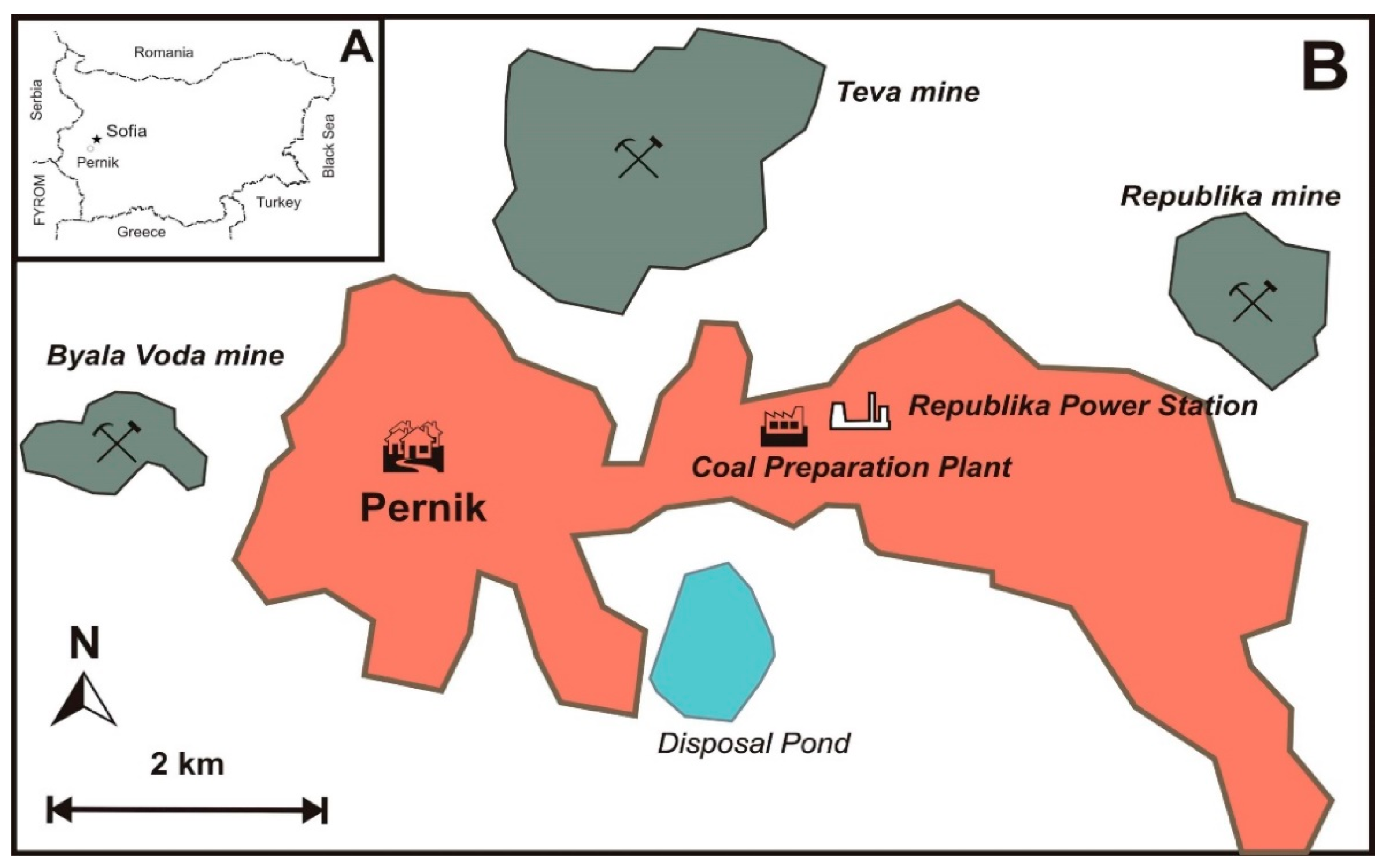
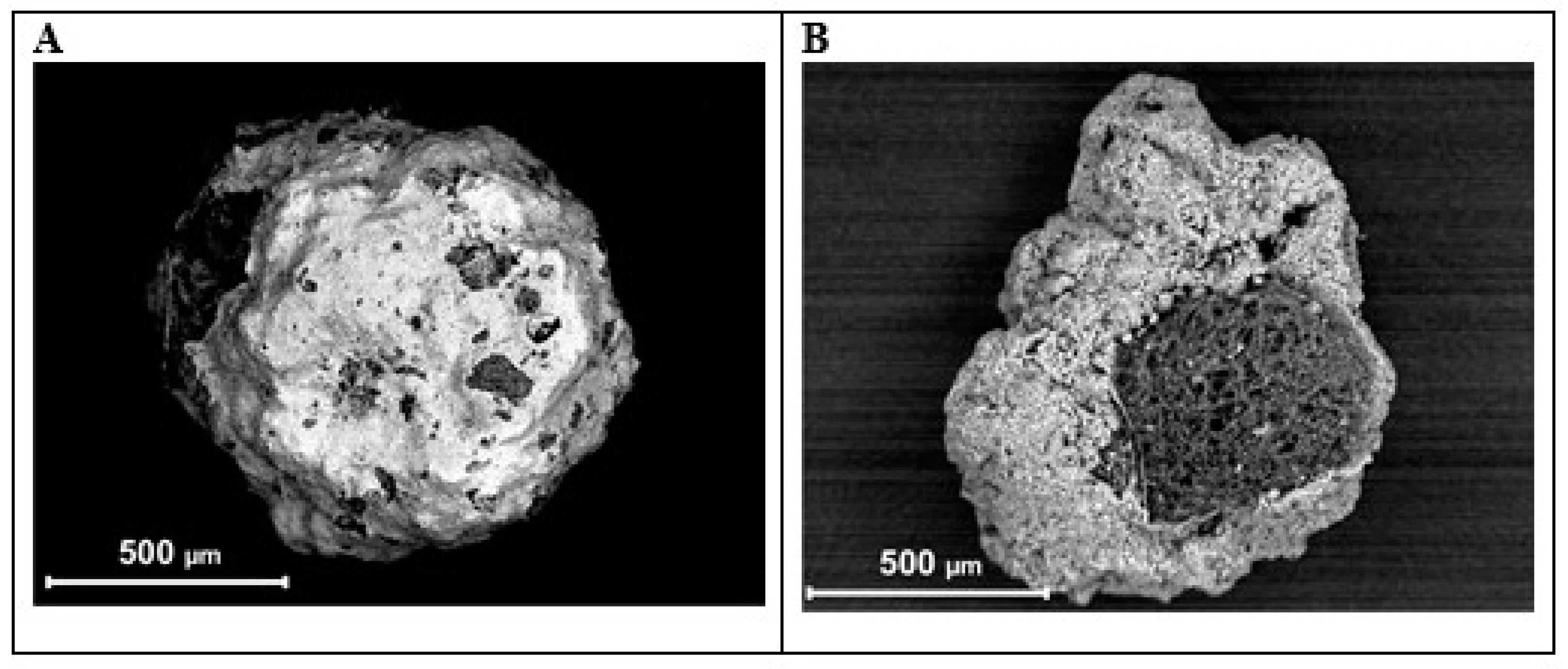
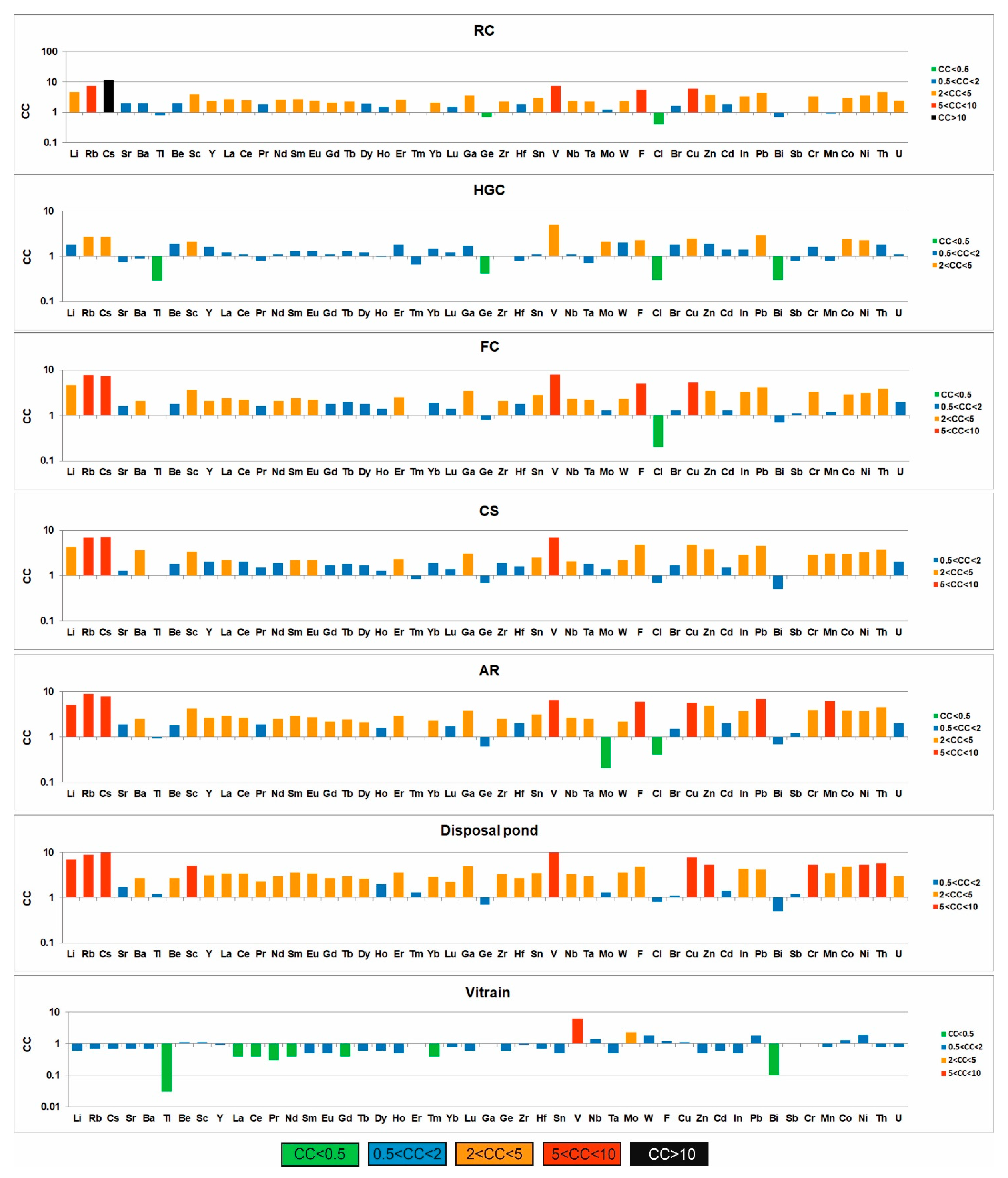
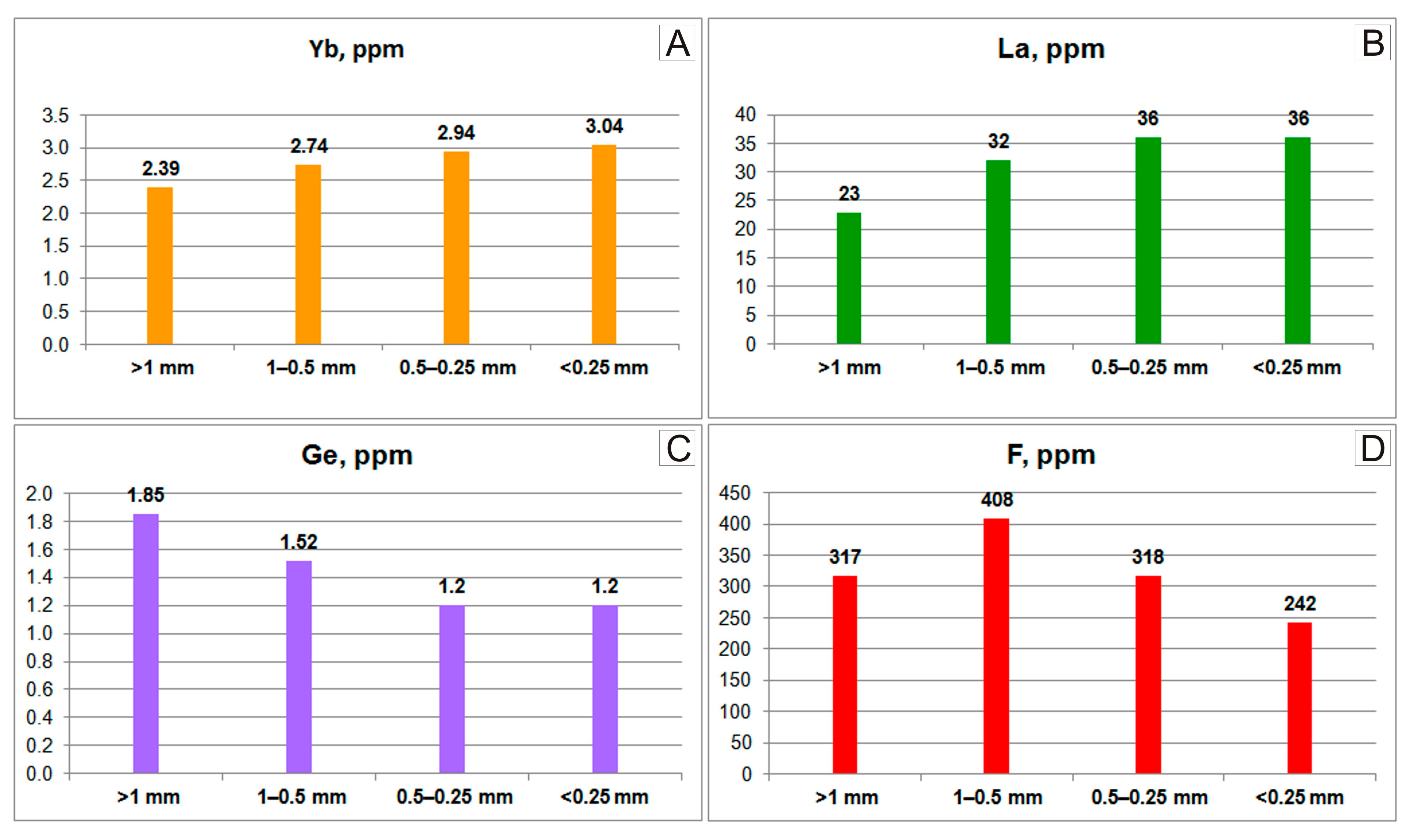
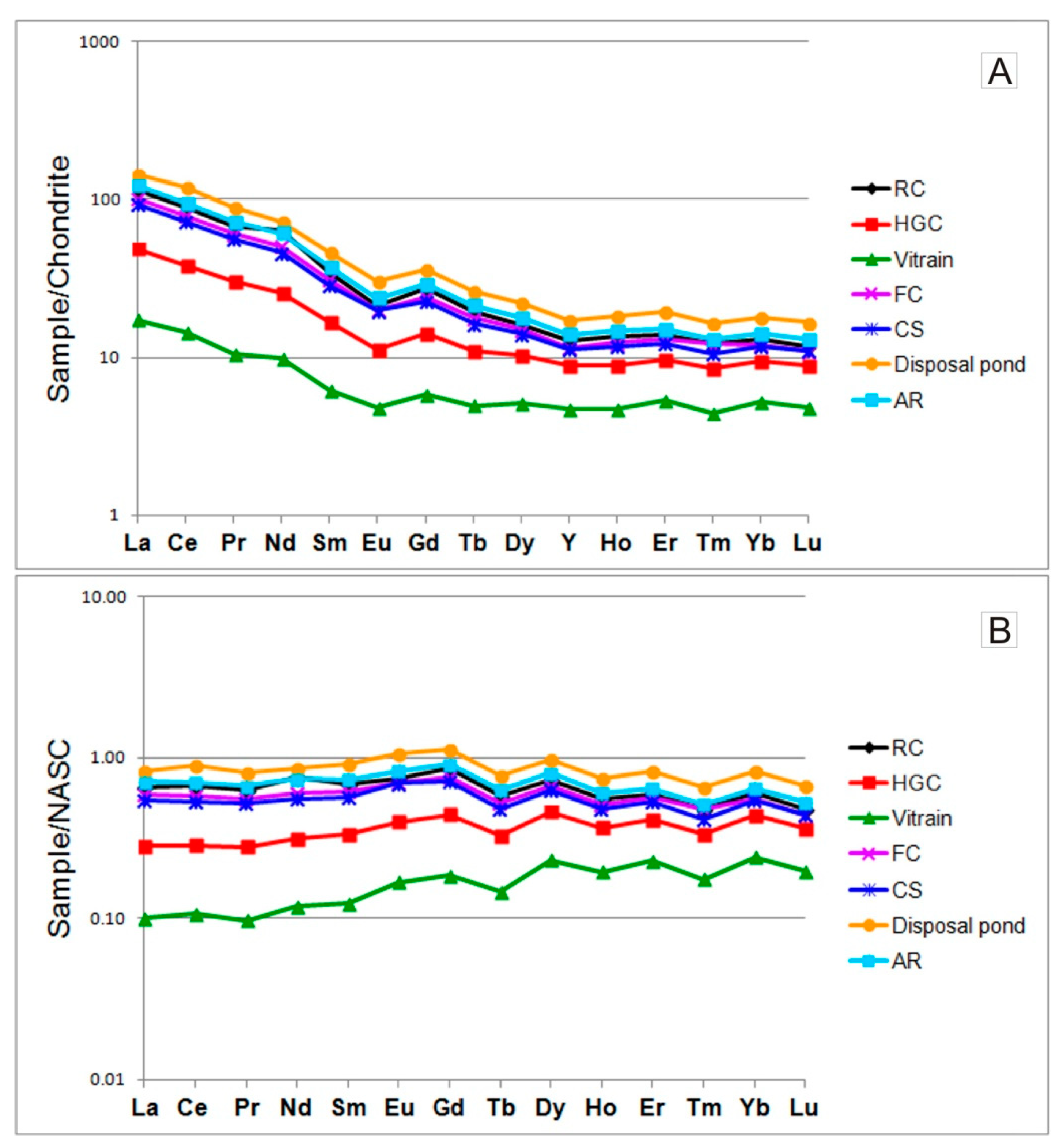
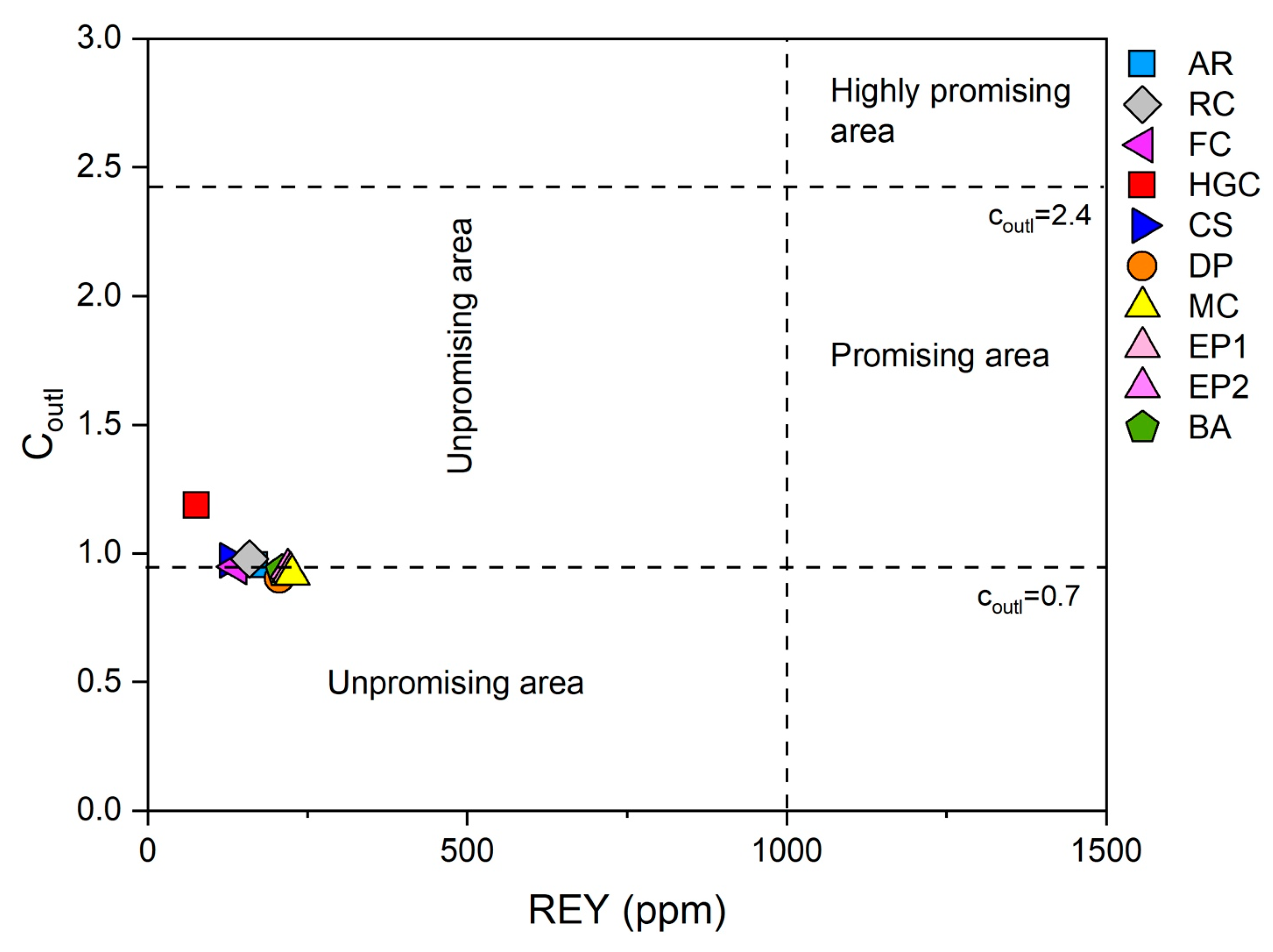
| Elements | Samples | World a Averages | ||||||
|---|---|---|---|---|---|---|---|---|
| RC | HGC | FC | CS | DP | AR | Vitrain | ||
| Lithophile elements | ||||||||
| Li | 46 | 18 | 46 | 43 | 69 | 51 | 6.0 | 10 |
| Rb | 73 | 27 | 77 | 69 | 88 | 91 | 6.5 | 10 |
| Cs | 12 | 2.7 | 7.3 | 6.9 | 9.8 | 7.6 | 0.7 | 0.98 |
| Sr | 245 | 90 | 195 | 158 | 199 | 224 | 84 | 120 |
| Ba | 304 | 130 | 315 | 546 | 410 | 376 | 105 | 150 |
| Tl | 0.57 | 0.2 | 0.65 | 0.66 | 0.82 | 0.63 | 0.02 | 0.68 |
| Be | 2.42 | 2.3 | 2.11 | 2.2 | 3.2 | 2.13 | 1.3 | 1.2 |
| Sc | 16 | 8.6 | 15 | 13.9 | 21 | 17 | 4.5 | 4.1 |
| Y | 20 | 14 | 18 | 17.6 | 27 | 22 | 7.4 | 8.6 |
| La | 27 | 12 | 24 | 22 | 34 | 29 | 4.2 | 10 |
| Ce | 55 | 24 | 48 | 44 | 74 | 58 | 8.9 | 22 |
| Pr | 6.3 | 2.8 | 5.6 | 5.2 | 8.2 | 6.7 | 0.98 | 3.5 |
| Nd | 29 | 12 | 23 | 21 | 33 | 28 | 4.5 | 11 |
| Sm | 5.1 | 2.5 | 4.6 | 4.2 | 6.8 | 5.5 | 0.93 | 1.9 |
| Eu | 1.2 | 0.64 | 1.12 | 1.11 | 1.7 | 1.34 | 0.27 | 0.50 |
| Gd | 5.4 | 2.8 | 4.8 | 4.5 | 7.1 | 5.8 | 1.11 | 2.6 |
| Tb | 0.71 | 0.4 | 0.64 | 0.59 | 0.95 | 0.77 | 0.18 | 0.32 |
| Dy | 4.0 | 2.5 | 3.7 | 3.47 | 5.4 | 4.4 | 1.26 | 2.1 |
| Ho | 0.74 | 0.49 | 0.68 | 0.64 | 1 | 0.81 | 0.26 | 0.50 |
| Er | 2.21 | 1.54 | 2.10 | 1.97 | 3.1 | 2.4 | 0.86 | 0.85 |
| Tm | 0.3 | 0.21 | 0.30 | 0.26 | 0.41 | 0.32 | 0.11 | 0.31 |
| Yb | 2.1 | 1.53 | 1.93 | 1.89 | 2.9 | 2.27 | 0.84 | 1.0 |
| Lu | 0.29 | 0.22 | 0.27 | 0.27 | 0.41 | 0.32 | 0.12 | 0.19 |
| Ga | 20 | 9.1 | 19.1 | 17.3 | 27 | 21 | 5.5 | 5.5 |
| Ge | 1.4 | 0.84 | 1.56 | 1.45 | 1.4 | 1.22 | 1.25 | 2.0 |
| Zr | 77 | 36 | 74 | 68 | 116 | 87 | 30 | 35 |
| Hf | 2.14 | 0.96 | 2.15 | 1.9 | 3.2 | 2.42 | 0.8 | 1.2 |
| Sn | 2.28 | 0.85 | 2.23 | 1.96 | 2.75 | 2.55 | 0.41 | 0.79 |
| V | 165 | 111 | 173 | 153 | 227 | 142 | 140 | 22 |
| Nb | 7.5 | 3.6 | 7.7 | 6.9 | 11 | 8.5 | 4.6 | 3.3 |
| Ta | 0.58 | 0.19 | 0.56 | 0.46 | 0.78 | 0.64 | 0.12 | 0.26 |
| Mo | 2.4 | 4.6 | 2.9 | 3 | 2.82 | 1.61 | 5.5 | 2.2 |
| W | 2.74 | 2.4 | 2.81 | 2.61 | 4.26 | 2.59 | 5 | 1.2 |
| F | 500 | 207 | 446 | 420 | 415 | 543 | 104 | 90 |
| Cl | 48 | 78 | 21 | 80 | 90 | 47 | nd | 120 |
| Br | 7.1 | 8.3 | 5.8 | 7.3 | 5 | 6.7 | nd | 4.4 |
| Sulfophile elements | ||||||||
| Cu | 91 | 38 | 80 | 70 | 117 | 85 | 16 | 15 |
| Zn | 68 | 35 | 63 | 69 | 95 | 88 | 8.8 | 18 |
| Cd | 0.43 | 0.33 | 0.32 | 0.36 | 0.34 | 0.46 | 0.14 | 0.24 |
| In | 0.07 | 0.03 | 0.07 | 0.06 | 0.09 | 0.078 | 0.01 | 0.021 |
| Pb | 29 | 19 | 28 | 30 | 28 | 45 | 12 | 6.6 |
| Bi | 0.59 | 0.24 | 0.52 | 0.38 | 0.41 | 0.57 | 0.1 | 0.84 |
| Sb | 0.84 | 0.7 | 0.96 | 0.85 | 1.0 | 0.98 | 0.86 | 0.84 |
| Siderophile elements | ||||||||
| Cr | 49 | 24 | 50 | 44 | 81 | 58 | 15 | 15 |
| Mn | 65 | 122 | 86 | 223 | 245 | 433 | 57 | 71 |
| Co | 12 | 9.9 | 12 | 12 | 20 | 16 | 5.5 | 4.2 |
| Ni | 32 | 21 | 28 | 30 | 49 | 33 | 17 | 9.0 |
| Radioactive elements | ||||||||
| Th | 15 | 6.1 | 13 | 12.3 | 19 | 15 | 2.8 | 3.3 |
| U | 7.1 | 3.1 | 5.9 | 5.8 | 8.8 | 5.7 | 2.2 | 2.9 |
| Ash yield, % | 59.2 | 26.8 | 59.9 | 70.4 | 95.6 | 79.1 | 8.8 | |
| Elements | BA | BA >1 mm | BA 1–0.5 mm | BA 0.5–0.25 mm | BA <0.25 mm | e/d | BA/FC |
|---|---|---|---|---|---|---|---|
| Fraction Yield, % | 3.1 | 13.6 | 41.6 | 41.7 | |||
| Lithophile elements | |||||||
| Li | 69 | 46 | 62 | 71 | 71 | 1.54 | 1.50 |
| Rb | 118 | 76 | 110 | 125 | 109 | 1.43 | 1.53 |
| Cs | 9.5 | 6.0 | 8.5 | 9.8 | 9.6 | 1.60 | 1.30 |
| Sr | 261 | 167 | 248 | 265 | 257 | 1.54 | 1.34 |
| Ba | 721 | 309 | 634 | 693 | 717 | 2.32 | 2.28 |
| Tl | 0.79 | 0.76 | 0.82 | 0.80 | 0.75 | 0.98 | 1.22 |
| Be | 2.8 | 2.5 | 2.5 | 2.8 | 2.8 | 1.12 | 1.33 |
| Sc | 22 | 16 | 20 | 23 | 23 | 1.43 | 1.47 |
| Y | 27 | 23 | 25 | 27 | 28 | 1.22 | 1.50 |
| La | 36 | 23 | 32 | 36 | 36 | 1.56 | 1.50 |
| Ce | 74 | 48 | 67 | 75 | 75 | 1.56 | 1.54 |
| Pr | 8.5 | 5.6 | 7.7 | 8.6 | 8.7 | 1.55 | 1.51 |
| Nd | 35 | 23 | 32 | 35 | 35 | 1.52 | 1.52 |
| Sm | 6.8 | 4.7 | 6.4 | 6.9 | 7.1 | 1.51 | 1.45 |
| Eu | 1.74 | 1.17 | 1.60 | 1.75 | 1.78 | 1.52 | 1.55 |
| Gd | 7.17 | 5.08 | 6.78 | 7.25 | 7.41 | 1.46 | 1.49 |
| Tb | 0.94 | 0.71 | 0.90 | 0.95 | 0.97 | 1.37 | 1.47 |
| Dy | 5.47 | 4.34 | 5.18 | 5.50 | 5.70 | 1.31 | 1.48 |
| Ho | 1.01 | 0.82 | 0.95 | 1.02 | 1.04 | 1.27 | 1.48 |
| Er | 3.05 | 2.55 | 2.87 | 3.06 | 3.15 | 1.23 | 1.45 |
| Tm | 0.40 | 0.34 | 0.38 | 0.40 | 0.42 | 1.23 | 1.33 |
| Yb | 2.90 | 2.39 | 2.74 | 2.94 | 3.04 | 1.27 | 1.50 |
| Lu | 0.41 | 0.34 | 0.39 | 0.41 | 0.42 | 1.23 | 1.52 |
| Ga | 24 | 18 | 23 | 25 | 24 | 1.33 | 1.25 |
| Ge | 1.3 | 1.85 | 1.52 | 1.20 | 1.20 | 0.65 | 0.83 |
| Zr | 112 | 90 | 107 | 111 | 112 | 1.24 | 1.51 |
| Hf | 3.16 | 2.45 | 2.92 | 3.02 | 3.03 | 1.23 | 1.47 |
| Sn | 2.25 | 2.10 | 3.39 | 2.19 | 2.16 | 1.03 | 1.00 |
| V | 213 | 228 | 207 | 211 | 220 | 0.96 | 1.23 |
| Nb | 10.7 | 8.3 | 9.9 | 10.8 | 10.9 | 1.31 | 1.38 |
| Ta | 0.83 | 0.58 | 0.76 | 0.83 | 0.81 | 1.40 | 1.48 |
| Mo | 3.0 | 4.2 | 4.4 | 2.90 | 3.10 | 0.74 | 1.03 |
| W | 3.5 | 2.9 | 3.8 | 3.40 | 3.40 | 1.17 | 1.24 |
| F | 301 | 317 | 408 | 318 | 242 | 0.76 | 0.67 |
| Cl | 55 | nd | nd | nd | nd | ||
| Br | 2 | nd | nd | nd | nd | ||
| Sulfophile elements | |||||||
| Cu | 111 | 88 | 120 | 111 | 120 | 1.36 | 1.38 |
| Zn | 81 | 65 | 106 | 85 | 111 | 1.71 | 1.28 |
| Cd | 0.23 | 0.29 | 0.28 | 0.23 | 0.22 | 0.76 | 0.72 |
| In | 0.08 | 0.06 | 0.08 | 0.07 | 0.07 | 1.16 | 1.14 |
| Pb | 26 | 26 | 31 | 25 | 24 | 0.93 | 0.92 |
| Bi | 0.16 | 0.27 | 0.25 | 0.13 | 0.20 | 1.31 | 0.31 |
| Sb | 0.96 | 1.48 | 1.56 | 0.88 | 0.89 | 1.20 | 1.00 |
| Siderophile elements | |||||||
| Cr | 92 | 63 | 114 | 94 | 91 | 1.44 | 1.84 |
| Mn | 353 | 412 | 445 | 328 | 384 | 0.93 | 5.69 |
| Co | 23 | 19 | 23 | 23 | 25 | 1.31 | 1.91 |
| Ni | 59 | 55 | 71 | 61 | 66 | 1.20 | 2.11 |
| Radioactive elements | |||||||
| Th | 18 | 12 | 16 | 19 | 19 | 1.58 | 1.46 |
| U | 7.2 | 6.1 | 6.4 | 7.0 | 7.5 | 1.23 | 1.22 |
| Ash yield, % | 94.3 | 64.3 | 88.6 | 96.2 | 97.7 | 1.51 | 1.57 |
| Elements | Samples | m/b | e1/b | e2/b | ||
|---|---|---|---|---|---|---|
| Mechanical Collector (MC) | Electrostatic Precipitators | |||||
| 1st Row (EP1) | 2nd Row (EP2) | |||||
| Lithophile elements | ||||||
| Li | 73 | 74 | 75 | 1.05 | 1.07 | 1.08 |
| Rb | 123 | 130 | 104 | 1.04 | 1.10 | 0.88 |
| Cs | 11.0 | 10 | 9.7 | 1.15 | 1.05 | 1.02 |
| Sr | 286 | 299 | 276 | 1.09 | 1.14 | 1.05 |
| Ba | 528 | 697 | 571 | 0.73 | 0.97 | 0.79 |
| Tl | 0.72 | 0.87 | 1.2 | 0.91 | 1.10 | 1.52 |
| Be | 2.9 | 3.01 | 3.44 | 1.03 | 1.07 | 1.23 |
| Sc | 24 | 25 | 24 | 1.09 | 1.13 | 1.09 |
| Y | 29 | 29 | 29 | 1.07 | 1.01 | 1.01 |
| La | 39 | 37 | 36 | 1.08 | 1.02 | 1.00 |
| Ce | 80 | 79 | 77 | 1.08 | 1.07 | 1.04 |
| Pr | 9.2 | 9.0 | 8.8 | 1.08 | 1.05 | 1.03 |
| Nd | 37 | 37 | 36 | 1.06 | 1.06 | 1.03 |
| Sm | 7.4 | 7.4 | 7.3 | 1.09 | 1.09 | 1.07 |
| Eu | 1.8 | 1.8 | 1.8 | 1.03 | 1.03 | 1.03 |
| Gd | 7.8 | 7.7 | 7.6 | 1.08 | 1.07 | 1.06 |
| Tb | 1.01 | 1.02 | 1.02 | 1.07 | 1.08 | 1.08 |
| Dy | 5.86 | 5.95 | 6.03 | 1.07 | 1.08 | 1.10 |
| Ho | 1.07 | 1.08 | 1.09 | 1.06 | 1.07 | 1.08 |
| Er | 3.27 | 3.29 | 3.36 | 1.06 | 1.08 | 1.10 |
| Tm | 0.44 | 0.43 | 0.44 | 1.10 | 1.07 | 1.10 |
| Yb | 3.1 | 3.2 | 3.2 | 1.07 | 1.10 | 1.10 |
| Lu | 0.44 | 0.44 | 0.45 | 1.07 | 1.07 | 1.10 |
| Ga | 24 | 28 | 36 | 1.00 | 1.16 | 1.50 |
| Ge | 1.17 | 2.4 | 4.2 | 0.90 | 1.84 | 3.23 |
| Zr | 110 | 130 | 142 | 0.98 | 1.16 | 1.27 |
| Hf | 3.12 | 3.6 | 3.9 | 0.98 | 1.14 | 1.23 |
| Sn | 2.30 | 3.2 | 4.8 | 1.02 | 1.42 | 2.13 |
| V | 213 | 280 | 328 | 1.00 | 1.31 | 1.54 |
| Nb | 10.9 | 12.4 | 13.8 | 1.02 | 1.16 | 1.29 |
| Ta | 0.91 | 0.95 | 0.99 | 1.09 | 1.14 | 1.19 |
| Mo | 2.77 | 3.8 | 5.7 | 0.92 | 1.26 | 1.90 |
| W | 3.9 | 3.4 | 4.4 | 1.11 | 0.97 | 1.26 |
| F | 303 | 571 | 1017 | 1.00 | 1.89 | 3.38 |
| Cl | 70 | 30 | 40 | 1.27 | 0.54 | 0.72 |
| Br | 3 | 5 | 2 | 1.5 | 2.50 | 1.00 |
| Sulfophile elements | ||||||
| Cu | 117 | 122 | 128 | 1.05 | 1.10 | 1.15 |
| Zn | 66 | 110 | 160 | 0.81 | 1.36 | 1.97 |
| Cd | 0.22 | 0.35 | 0.52 | 0.96 | 1.52 | 2.26 |
| In | 0.07 | 0.1 | 0.16 | 0.87 | 1.25 | 2.00 |
| Pb | 22 | 38 | 64 | 0.84 | 1.46 | 2.46 |
| Bi | 0.17 | 0.61 | 1.19 | 1.06 | 3.81 | 7.43 |
| Sb | 0.91 | 1.37 | 2.11 | 0.95 | 1.43 | 2.19 |
| Siderophile elements | ||||||
| Cr | 84 | 101 | 101 | 0.91 | 1.09 | 1.09 |
| Mn | 382 | 246 | 227 | 1.08 | 0.69 | 0.64 |
| Co | 21 | 22 | 22 | 0.91 | 0.96 | 0.96 |
| Ni | 48 | 61 | 62 | 0.81 | 1.03 | 1.05 |
| Radioactive elements | ||||||
| Th | 21 | 19 | 19 | 1.11 | 1.00 | 1.00 |
| U | 8.3 | 7.9 | 8.7 | 1.15 | 1.10 | 1.2 |
| Ash yield.% | 97.9 | 98.7 | 98.6 | 1.03 | ||
| Samples | RC | HGC | FC | CS | DP | AR | Vitrain | BA | MC | ESP Ash |
|---|---|---|---|---|---|---|---|---|---|---|
| ∑REE | 139 | 51 | 123 | 111 | 290 | 146 | 24.4 | 270 | 197 | 192 |
| LREE/HREE | 7.8 | 5.4 | 6.2 | 7.2 | 7.4 | 7.5 | 4.09 | 7.58 | 7.58 | 7.32 |
| CeN/YbN 1 | 6.87 | 4.05 | 6.53 | 6.11 | 6.71 | 6.71 | 2.77 | 6.71 | 6.76 | 6.95 |
| Eu/Eu* 1 | 0.69 | 0.72 | 0.72 | 0.77 | 0.74 | 0.72 | 0.79 | 0.75 | 0.72 | 0.72 |
Disclaimer/Publisher’s Note: The statements, opinions and data contained in all publications are solely those of the individual author(s) and contributor(s) and not of MDPI and/or the editor(s). MDPI and/or the editor(s) disclaim responsibility for any injury to people or property resulting from any ideas, methods, instructions or products referred to in the content. |
© 2024 by the authors. Licensee MDPI, Basel, Switzerland. This article is an open access article distributed under the terms and conditions of the Creative Commons Attribution (CC BY) license (https://creativecommons.org/licenses/by/4.0/).
Share and Cite
Yossifova, M.G.; Eskenazy, G.M.; Vassilev, S.V.; Dimitrova, D.A. Trace Elements in Pernik Sub-Bituminous Coals and Their Combustion Products Derived from the Republika Thermal Power Station, Bulgaria. Minerals 2024, 14, 313. https://doi.org/10.3390/min14030313
Yossifova MG, Eskenazy GM, Vassilev SV, Dimitrova DA. Trace Elements in Pernik Sub-Bituminous Coals and Their Combustion Products Derived from the Republika Thermal Power Station, Bulgaria. Minerals. 2024; 14(3):313. https://doi.org/10.3390/min14030313
Chicago/Turabian StyleYossifova, Mariana G., Greta M. Eskenazy, Stanislav V. Vassilev, and Dimitrina A. Dimitrova. 2024. "Trace Elements in Pernik Sub-Bituminous Coals and Their Combustion Products Derived from the Republika Thermal Power Station, Bulgaria" Minerals 14, no. 3: 313. https://doi.org/10.3390/min14030313
APA StyleYossifova, M. G., Eskenazy, G. M., Vassilev, S. V., & Dimitrova, D. A. (2024). Trace Elements in Pernik Sub-Bituminous Coals and Their Combustion Products Derived from the Republika Thermal Power Station, Bulgaria. Minerals, 14(3), 313. https://doi.org/10.3390/min14030313







